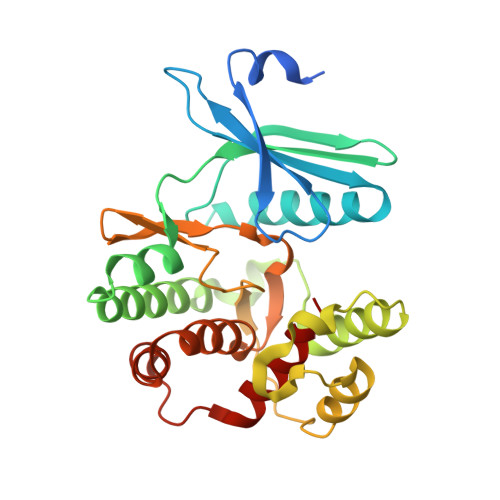Structure-guided optimization of protein kinase inhibitors reverses aminoglycoside antibiotic resistance.
Stogios, P.J., Spanogiannopoulos, P., Evdokimova, E., Egorova, O., Shakya, T., Todorovic, N., Capretta, A., Wright, G.D., Savchenko, A.(2013) Biochem J 454: 191-200
- PubMed: 23758273
- DOI: https://doi.org/10.1042/BJ20130317
- Primary Citation of Related Structures:
4EJ7, 4FEU, 4FEV, 4FEW, 4FEX, 4GKH, 4GKI - PubMed Abstract:
Activity of the aminoglycoside phosphotransferase APH(3')-Ia leads to resistance to aminoglycoside antibiotics in pathogenic Gram-negative bacteria, and contributes to the clinical obsolescence of this class of antibiotics. One strategy to rescue compromised antibiotics such as aminoglycosides is targeting the enzymes that confer resistance with small molecules. We demonstrated previously that ePK (eukaryotic protein kinase) inhibitors could inhibit APH enzymes, owing to the structural similarity between these two enzyme families. However, limited structural information of enzyme-inhibitor complexes hindered interpretation of the results. In addition, cross-reactivity of compounds between APHs and ePKs represents an obstacle to their use as aminoglycoside adjuvants to rescue aminoglycoside antibiotic activity. In the present study, we structurally and functionally characterize inhibition of APH(3')-Ia by three diverse chemical scaffolds, anthrapyrazolone, 4-anilinoquinazoline and PP (pyrazolopyrimidine), and reveal distinctions in the binding mode of anthrapyrazolone and PP compounds to APH(3')-Ia compared with ePKs. Using this observation, we identify PP derivatives that select against ePKs, attenuate APH(3')-Ia activity and rescue aminoglycoside antibiotic activity against a resistant Escherichia coli strain. The structures described in the present paper and the inhibition studies provide an important opportunity for structure-based design of compounds to target aminoglycoside phosphotransferases for inhibition, potentially overcoming this form of antibiotic resistance.
Organizational Affiliation:
Department of Chemical Engineering and Applied Chemistry, University of Toronto, Ontario, Canada.


















